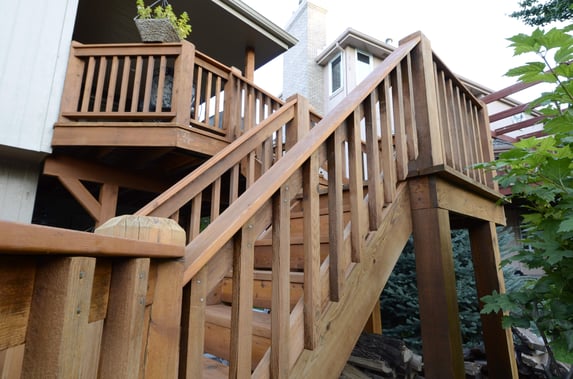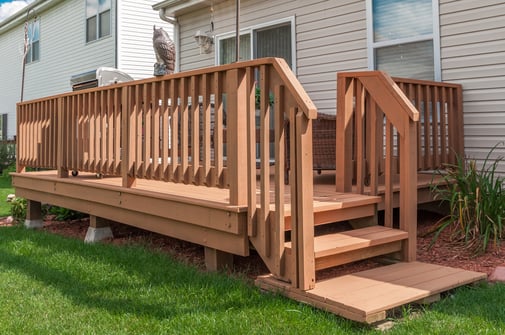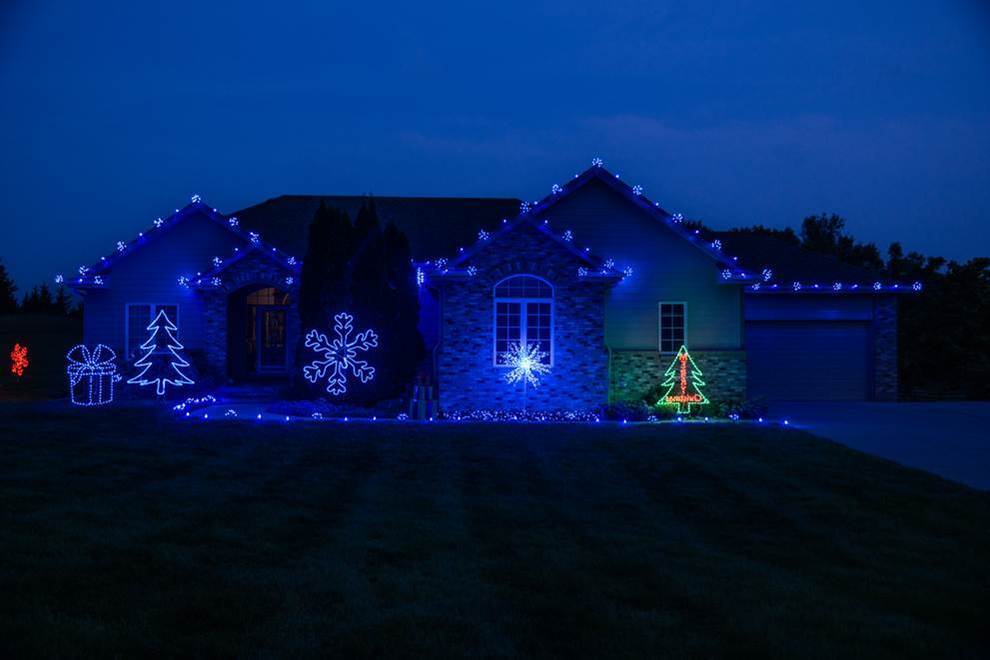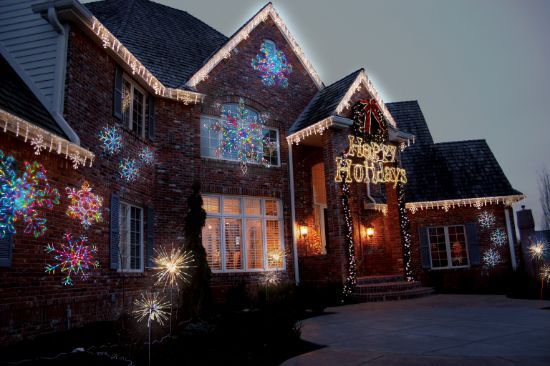Will Ice Melt Damage Your Stained Deck in Winter?
November 7th, 2025
5 min read
-Jul-23-2025-02-21-33-5468-PM.png?width=800&height=418&name=Blog%20Post%20Image%20Size%20(2)-Jul-23-2025-02-21-33-5468-PM.png)
You finally did it, after putting it off, you hired a painter to sand, clean, and stain your deck and it looks beautiful again. The color is rich, the finish feels smooth under your feet, and you can almost hear the sizzle of next summer’s first barbecue. Then winter rolls in. Snow piles up, temperatures drop, and you find yourself grabbing a bag of salt or ice melt just to make sure nobody slips on the steps. But then the thought hits you, will this damage my deck stain? You made an investment in your deck, and the last thing you want is to see it peel, fade, or discolor before spring even arrives.
At Brush & Roll Painting, we’ve helped Omaha homeowners protect and restore decks for nearly three decades. We’ve seen what Nebraska winters can do to wood, from moisture creeping under finishes to salt residue eating away at coatings. We know which products hold up, which ones don’t, and how to balance safety with long-term deck health.
This article will help you understand how ice melt and salt can affect your stained deck, which types are safer to use, and what you can do to protect your deck through the winter. By the end, you’ll know exactly how to keep your deck both safe to walk on and beautiful when spring returns.
How Salt and Ice Melt Affects Stained Wood Decks
When temperatures drop below freezing, homeowners often use ice melt to prevent slipping. The problem is that most of these products are made for concrete or asphalt, not wood.
Traditional rock salt (sodium chloride) works by lowering the freezing point of water, but it’s highly corrosive. When used on wood, it can:
- Break down the finish: Salt can strip away the protective layer of your deck stain, especially if the coating is thin or worn in high-traffic areas.
- Dry out the wood: Salt absorbs moisture, pulling it from the wood fibers and causing the deck boards to become brittle over time.
- Cause discoloration: White salt residue can dull or lighten your deck color, making it look patchy or chalky by spring.
- Increase water penetration: Once salt damages the stain, water can soak into the wood more easily, leading to peeling, cracking, and mildew.
In short, yes, ice melt and salt can absolutely damage a stained deck if used the wrong way. But that doesn’t mean you have to choose between safety and preservation.

Which Types of Ice Melt Are Safe for a Stained Deck?
Not all deicers are equal. Some are much gentler on wood surfaces, though they still require care. Here’s a breakdown:
1. Calcium Magnesium Acetate (CMA)
This is one of the safest options for decks. CMA is biodegradable and less corrosive than salt. It works best in temperatures down to about 20°F, so it’s effective for most Omaha winter days. It doesn’t harm wood fibers or strip finishes as aggressively as sodium chloride.
2. Magnesium Chloride
Magnesium chloride is another safer choice. It’s less likely to leave white residue and works down to around -13°F, which covers even the coldest Nebraska nights. It’s also less drying to wood than rock salt.
3. Calcium Chloride
This type of ice melt is powerful and fast-acting, but it can leave an oily residue that dulls your deck’s appearance. It’s safer than sodium chloride but should be used sparingly.
4. Urea-Based Deicers
Often used around pets and plants, urea-based products are less corrosive but only work in mild freezing conditions (around 25°F and above). These can be a good option for late fall or early spring.
Products to Avoid on a Stained Deck
Even if something works well on your driveway, it may not belong on your deck. Avoid:
- Rock salt (sodium chloride): It’s cheap, but it’s harsh on wood, plants, and metal railings.
- Products with added sand: The grit can scratch your deck’s surface and wear down the stain faster.
- Fertilizer blends: Some homeowners use leftover fertilizer as a deicer, but it can stain wood and harm plants around the deck.
If you’re unsure what you’re using, read the product label carefully. Many ice melts are blended, so even if they advertise “safe for pets,” they might not be safe for stained wood.
-Nov-06-2024-10-29-56-1258-PM.png?width=633&height=331&name=Blog%20Post%20Image%20Size%20(2)-Nov-06-2024-10-29-56-1258-PM.png)
How to Protect Your Deck During Winter
You can prevent most winter damage by combining safe products with a few extra precautions.
1. Clear Snow Regularly
Don’t wait for the snow to melt on its own. The longer it sits, the more moisture seeps into the wood. Use a broom, not a shovel, to avoid gouging the surface. Sweep along the grain of the boards rather than across them.
2. Use Ice Melt Sparingly
If you need traction, sprinkle ice melt lightly in high-traffic spots like stairs or pathways. Sweep up leftover product once the ice melts.
3. Lay Down Mats or Outdoor Rugs
Rubber or heavy-duty mats can protect the finish in areas where you walk the most. Just make sure the material allows airflow underneath so moisture doesn’t get trapped.
4. Inspect for Damage in Early Spring
Once the snow is gone, look for fading, dull spots, or peeling stain. Early repairs prevent more serious damage later in the year.
5. Reapply Protective Coating as Needed
If your deck was stained last summer or fall, it should still have protection. But if it’s been a couple of years, a maintenance coat in spring can restore color and sealing power.
How Omaha Winters Add Extra Stress For Wood
Nebraska’s weather doesn’t play fair. One week it’s sunny and 50 degrees, and the next it’s below zero. These freeze-thaw cycles are especially tough on outdoor wood. As temperatures fluctuate, moisture in and under the deck expands and contracts, which can cause even a well-sealed deck to crack if it’s exposed.
That’s why using the right ice melt matters so much here. The wrong product won’t just dull your stain; it can accelerate the breakdown that Omaha’s climate already encourages.
A well-prepared deck, sealed properly before the first frost, can resist these conditions far better than one with a cheap stain or worn-out coating. That’s also why professional prep work, sanding, cleaning, and applying high-quality products pays off long-term.
-Aug-21-2024-01-37-28-1673-PM.png?width=647&height=338&name=Blog%20Post%20Image%20Size%20(2)-Aug-21-2024-01-37-28-1673-PM.png)
What If Salt Has Already Damaged My Deck?
If you’ve used salt before reading this article, don’t panic. Most surface damage can be reversed with a spring refresh. Here’s what you can do:
- Rinse thoroughly: As soon as the weather warms up, rinse your deck with a hose or low-pressure washer to remove salt residue.
- Use a wood cleaner: A specialized cleaner will help lift contaminants that are embedded in the grain. You can either rent a power washer and use it on a low setting, hire someone to do it for you, or use your garden hose.
Likely, you can stop here and assess the situation.
- Lightly sand problem areas: This removes raised fibers and dull residue if needed.
- Restain or reseal: Apply a fresh coat of your existing deck stain to restore color and protection. The wood needs to be at least 45°F and free from salt residue before applying the new stain. You’ll want to clean and rinse thoroughly before any re-coating. This is usually done in late March or April in Omaha when the weather starts stabilizing.
If you notice gray patches, heavy peeling, or deep cracking, you may need a full restoration. Professional painters can sand it back down and reapply the stain so it looks brand new again.
Should You Just Let Snow Sit on Decks?
Some homeowners think it’s better to avoid ice melt altogether and just let snow pile up. While that avoids chemical damage, it can cause other problems. Sitting snow means constant moisture, and when it melts, it can lead to mildew or rot.
The best approach is balance: keep your deck clear, but don’t overuse ice melt. A broom or plastic shovel, combined with safe deicers in small amounts, keeps both your family and your finish protected.

How Long Should a Deck Stain Last?
A well-maintained deck stain should last around 2 to 4 years on horizontal surfaces and 3 to 5 years on vertical ones, depending on product quality and exposure. High-end coatings, such as those applied professionally with proper prep, can stretch toward the upper end of that range, even through several Omaha winters.
But the key factor isn’t just the stain itself; it’s how the deck is cared for between seasons. Preventing salt buildup, snow pooling, and standing moisture goes a long way toward keeping your deck stain looking rich and even.
Deck Staining in Omaha, NE
If you recently invested in staining your deck, you deserve for it to stay looking great all year long. Ice melt and salt can damage stained decks if used carelessly, but by choosing safer products, clearing snow properly, and maintaining your finish each spring, you can prevent long-term issues.
At Brush & Roll Painting, we have been helping Omaha homeowners protect their decks since 1996. Our goal is to make sure your outdoor spaces stay both safe and beautiful through every season.
Click the button below to get a quote for professional deck staining.
If you’re not ready to schedule yet, try our deck staining pricing calculator to get an idea of what your next project may cost.
Kaylea is the Brush & Roll Painting Content Manager. Kaylea is a Journalism and Media Communications summa cum laude graduate with a minor in Marketing from the University of Nebraska at Omaha. Kaylea manages the marketing for Brush & Roll Painting.
Topics:


















-Oct-22-2025-01-39-19-5208-PM.png?width=800&height=418&name=Blog%20Post%20Image%20Size%20(1)-Oct-22-2025-01-39-19-5208-PM.png)







